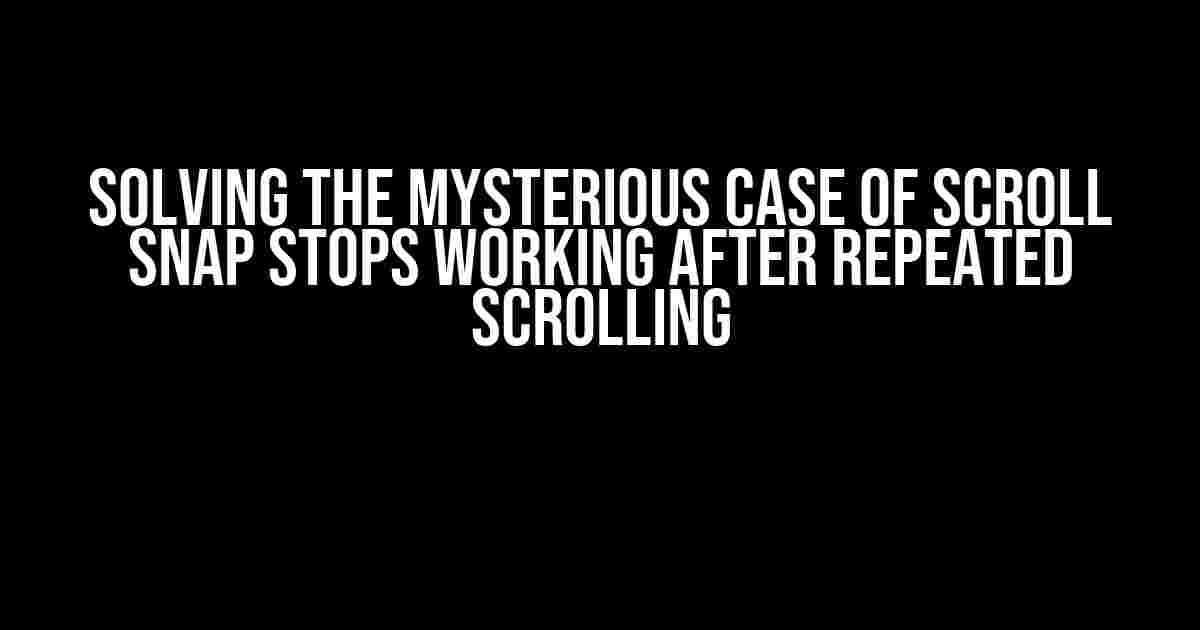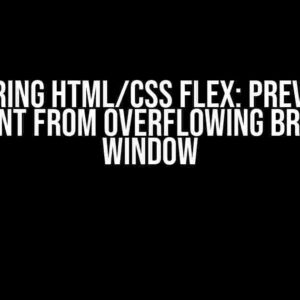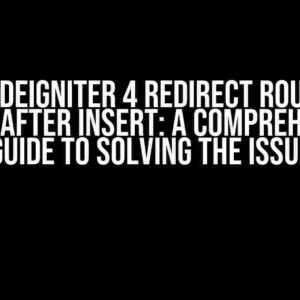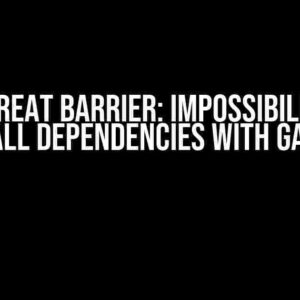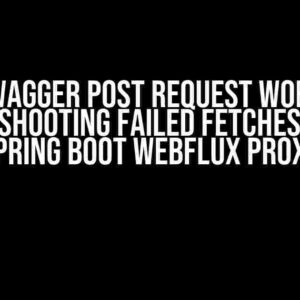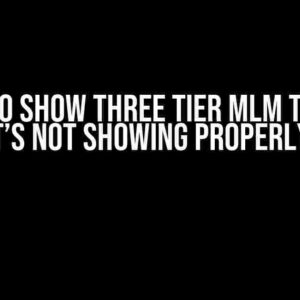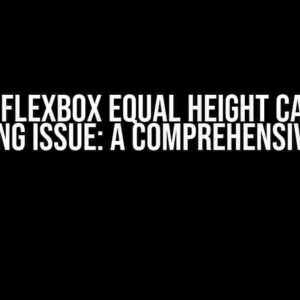Have you ever encountered the frustrating issue of scroll snap stops working after repeated scrolling? You’re not alone! This pesky problem has plagued many a web developer, leaving us scratching our heads and wondering what went wrong. Fear not, dear reader, for we’re about to dive into the depths of this issue and emerge victorious on the other side.
What is Scroll Snap, Anyway?
Before we tackle the problem at hand, let’s take a brief detour to understand what scroll snap is all about. Scroll snap, also known as scroll snap points or snap points, is a feature that allows web developers to define specific points on a webpage where the scrollbar will “snap” or “lock” into place. This creates a seamless user experience, especially on mobile devices where precise scrolling can be a challenge.
How Scroll Snap Works
Scroll snap relies on the `scroll-snap-type` property, which is applied to a container element (e.g., a `
scroll-snap-type: x mandatory: Snap points are created along the x-axis (horizontal).scroll-snap-type: y mandatory: Snap points are created along the y-axis (vertical).
In addition to the `scroll-snap-type` property, you’ll need to define the snap points themselves using the `scroll-snap-align` property. This property specifies the alignment of the snap point within the container.
The Culprit: Repeated Scrolling
Now that we’ve covered the basics of scroll snap, let’s delve into the issue at hand: scroll snap stops working after repeated scrolling. You’ve applied the necessary CSS properties, and everything seems to be working just fine… until it doesn’t.
Symptoms and Troubleshooting
Here are some common symptoms and troubleshooting steps to help you identify the problem:
| Symptom | Troubleshooting Step |
|---|---|
| Scroll snap stops working after scrolling up and down multiple times. | Check for any dynamically added or removed elements within the scroll container. Ensure that the `scroll-snap-type` property is re-applied after any DOM mutations. |
| Scroll snap points are not triggered when scrolling slowly. | Verify that the `scroll-snap-align` property is correctly set for each snap point. Try adjusting the `scroll-snap-align` values to see if it makes a difference. |
| The scroll container’s height or width is not set. | Ensure that the scroll container has a fixed height or width set, as scroll snap relies on these dimensions to function correctly. |
Solutions to the scrolled Conundrum
Now that we’ve identified some potential causes, let’s dive into the solutions:
1. Disable Scroll Anchoring
One possible culprit behind scroll snap stops working is scroll anchoring, a feature introduced in Chrome 56. To disable scroll anchoring, add the following CSS property to your scroll container:
.scroll-container {
overflow-anchor: none;
}
2. Use `scroll-snap-type: proximity` Instead of `mandatory`
Try switching from `scroll-snap-type: mandatory` to `scroll-snap-type: proximity`. This property tells the browser to snap to the nearest snap point, rather than enforcing a strict snap point alignment.
.scroll-container {
scroll-snap-type: y proximity;
}
3. Apply `scroll-snap-stop: always` to the Scroll Container
This property ensures that the browser will always snap to a snap point, even when the user scrolls rapidly.
.scroll-container {
scroll-snap-stop: always;
}
4. Add a Debounce Function to Handle Repeated Scrolling
Implement a debounce function to limit the frequency of scroll events, reducing the likelihood of scroll snap stops working. You can use a JavaScript library like Lodash or create your own debounce function.
function debounce(fn, delay) {
let timeout;
return function() {
const context = this;
const args = arguments;
clearTimeout(timeout);
timeout = setTimeout(() => {
fn.apply(context, args);
}, delay);
};
}
const scrollContainer = document.querySelector('.scroll-container');
const handleScroll = debounce(() => {
// Your scroll event handling code here
}, 300);
scrollContainer.addEventListener('scroll', handleScroll);
Conclusion
There you have it, folks! By following these troubleshooting steps and solutions, you should be able to resolve the issue of scroll snap stops working after repeated scrolling. Remember to keep an eye out for those pesky DOM mutations, and don’t hesitate to experiment with different scroll snap properties to find the perfect fit for your project.
Final Checklist
Before you go, make sure to review this final checklist to ensure you’ve covered all your bases:
- Verify that the `scroll-snap-type` property is correctly applied to the scroll container.
- Check that the `scroll-snap-align` property is set for each snap point.
- Ensure the scroll container has a fixed height or width set.
- Disable scroll anchoring if necessary.
- Try using `scroll-snap-type: proximity` instead of `mandatory`.
- Apply `scroll-snap-stop: always` to the scroll container.
- Implement a debounce function to handle repeated scrolling.
With these tips and tricks up your sleeve, you’ll be well on your way to creating seamless scroll snap experiences that will leave your users delighted and engaged. Happy coding!
Frequently Asked Question
Are you tired of dealing with scroll snap stops working after repeated scrolling? We’ve got you covered! Check out these frequently asked questions to troubleshoot the issue and get back to smooth scrolling in no time.
Why does scroll snap stop working after repeated scrolling?
One common reason is that the browser’s scroll snap mechanism can get overwhelmed by repeated scrolling, causing it to malfunction. This can happen when you rapidly scroll up and down or use a non-standard scrolling method. Additionally, issues with CSS or JavaScript code, device limitations, or outdated browser versions can also contribute to this problem.
How can I reset scroll snap after repeated scrolling?
Try reloading the page or restarting your browser to reset the scroll snap mechanism. You can also try removing any custom CSS or JavaScript code that might be interfering with the scroll snap functionality. If the issue persists, try updating your browser to the latest version or checking for any device-specific issues.
Can I improve scroll snap performance to prevent it from stopping?
Yes! Optimize your CSS and JavaScript code to reduce the load on the browser’s scroll snap mechanism. Use efficient scrolling libraries, minimize DOM manipulation, and leverage browser caching to improve performance. You can also consider using alternative scrolling methods, such as scroll anchoring, to reduce the load on the browser.
Is there a way to detect when scroll snap stops working?
Yes, you can use JavaScript to detect when scroll snap stops working. Listen for the ‘scroll’ event and check if the browser’s scroll snapped position matches the expected position. If not, you can trigger a reset or reload the page to restore scroll snap functionality. You can also use browser dev tools to debug and identify the issue.
Can I force scroll snap to work even after repeated scrolling?
While there’s no foolproof way to force scroll snap to work in all cases, you can try using a scroll snap polyfill or a custom scrolling library that can handle repeated scrolling. Alternatively, consider implementing a custom scrolling solution that bypasses the browser’s native scroll snap mechanism. However, be cautious when doing so, as it may affect browser compatibility and performance.

